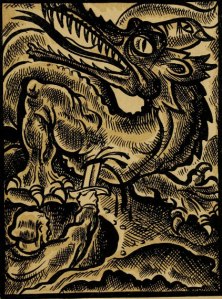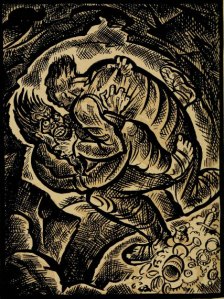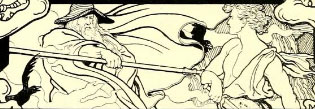Rings of Power: Wagner and Tolkien
When the Swedish writer Ake Ohlmark suggested that the Ring of Power in J. R. R. Tolkien’s Lord of the Rings bears a certain resemblance to Wagner’s Ring of the Nibelung, Tolkien impatiently replied that “Both rings are round, and there the resemblance ceases.” (1)
Within Tolkien’s correspondence and notes, this is the only direct reference to the Nibelungen Ring that I’ve been able to find. This is perplexing, given how obvious it is that Wagner exerted an immense influence over Tolkien’s creative work.
Perhaps this is a case of what Harold Bloom called the anxiety of influence; in which an artist goes to great lengths to disavow an obviously-influential predecessor, such as when Freud claimed that he never read Nietzsche. Or perhaps, as a friend of mine suggested recently, when it comes to an artist like Wagner, acknowledging influence is sometimes impossible, because their conception is too vast, and any artist would drown in it.
Whatever the case may be, many of the important characters, themes, and episodes in Tolkien’s trilogy have close counterparts in Wagner’s cycle. In what follows, I’d like to excavate some of these instances by comparing motifs from both works. There will be many spoilers.
The most obvious point of comparison between Lord of the Rings and the Nibelungen Ring is that both works feature magical rings, and, contrary to Tolkien’s objections, the two rings are identical in nearly every way.
Both rings are powerful magical artifacts associated with command and control, forged by demonic beings who renounce love in favor of hate, anger and dominion. Both excite an ungovernable lust in people to possess and wield the ring, which acts as a profoundly corrupting force that incites fratricide or its equivalent, bringing heroes to conflict and moral crisis. The struggle for possession of both rings sets in motion the central actions of the plots, leading to a titanic conflict and shift of the world-age.
It is sometimes pointed out by Tolkien’s defenders that he utilized many of the same sources as Wagner, and, as a philologist with a genuine command of the languages in question, he frequently knew them better than Wagner did. For example, both artists made extensive use of medieval German and Icelandic sagas and legends, such as the Eddas, the Volsung Saga, and the Nibelungenlied.
However, the Ring of Power is purely a creation of Wagner’s imagination. As Deryck Cooke wrote in I Saw the World End, a key work of Wagner scholarship:
The whole importance of gold in Wagner’s work, of course, is its potentiality for being made into a ring conferring absolute world-power; and again, this element is absent from the mythology…. [T]he power of Wagner’s ring is ultimately the power of the ring of the Scandinavian sources to multiply wealth; but in making this power an absolute dominion over the world, he added a crucial element of his own, which these sources do not contain. Nor do the German sources contain it: a ring of this kind is entirely absent from the Nibelung hoard. (2) [emphasis added]
Although various enchanted rings exist in the old mythology, the Ring of Power as a tool and symbol of dominion is Wagner’s invention.
In Scene 4 of Wagner’s Das Rheingold, the brothers Fafner and Fasolt, under the spell of the ring’s corrupting power, abruptly turn on one another:
Fasolt: (hurls himself upon Fafner, who has been busily packing away.) Stand back, you robber! Mine is the ring; I won it for Freia’s glance! (He snatches hastily at the ring. They struggle)
Fafner: Off with your hands! The ring is mine! (Fasold wrests the ring from Fafner.)
Fasolt: I have it, I shall keep it!
Fafner: (striking out with his staff) Hold it fast, else it may fall! (He fells Fasolt with a single blow and then wrenches the ring from the dying giant.) (3)
Compare to Gandalf’s account in Fellowship of the Ring:
‘”Give us that [ring], Déagol, my love,” said Sméagol, over his friend’s shoulder.
‘”Why?’ said Déagol.
‘”Because it’s my birthday, my love, and I wants it,” said Sméagol.
‘”I don’t care,” said Déagol. “I have already given you a present already, more than I could afford. I found it, and I”m going to keep it.”
‘”Oh, are you indeed, my love,” said Sméagol, and caught Déagol by the throat, and strangled him, because the gold looked so bright and beautiful. (4)
Like Wagner’s cycle, Tolkien’s story depicts a ring that inflames lust for ownership. Once under its spell, owners of the ring will never willingly give it up, and, should they lose it, they become obsessed with its recovery. Like the dwarf Alberich, Gollum conspires secretly and treacherously to win it back from the hero who has taken it.
Like Biblo and Frodo Baggins, Siegfried is shielded from the dark power of the ring by his innocence. Alberich observes “But [Siegfried] that boldest of heroes is safe from my curse; for he knows not the might of the ring; he makes no use of its magical power.” [283]
Both rings were forged by sinister beings who renounce love in favor of mastery and dominion. Both stories end with the rings being unmade. The Ring of Power is cast into the lava of Mount Doom, where it was forged; the Nibelungen Ring is cast back into the Rhine, from whence its enchanted gold was stolen. The return of each ring to its source touches off a cataclysmic eruption.
There are too many additional points of similarity to be cataloged, so I will only briefly review some of the most obvious.
Smaug will remind any Wagner fan of Fafner, who takes the form of a dragon and sleeps in a cave atop his pile of magic treasure. The slaying of both dragons is tied to crucial advice given to the hero by a bird, whose song can be understood.
“As ‘Wanderer’ am I known to the world, wide have I fared, and far have I traveled over the earth’s broad back,” says Wotan in Siegfried. Gandalf’s “gray pilgrim” is exceedingly similar. Like Wotan, he is viewed warily by provincial folk, who may greet him as Mime greets Wotan, with the words “Ill fortune dwells with me already; why do you add to it?” We hear the echo of Grima Wormtongue: Wotan Stormcrow!
The line of Aragorn, heir of Isildur and Elendil, shows pervasive similarities with the family of Sigmund and Siegfried. Here, I grant, both authors probably worked under the strong influence of the Saga of the Volsungs, but I doubt anyone who knows their Tolkien will not be startled by the similarities as they experience the Ring Cycle.
Both stories feature heroes who are of kingly lineage, but who are forced into a life of obscurity, living in the forest as masters of woodcraft, performing heroic but unsung deeds to protect the innocent.
Aragorn’s ancestor Isildur fell in battle with Sauron, during which his blade was broken, and its pieces bequeathed to the lineage, to be kept against the day that it should be reforged and the line renewed. Siegmund fell in battle with Hunding, during which his blade was broken, being given into safekeeping against the day his son, Siegfried, would finally reforge it, and begin his own adventure.
To any reader who is armed with a familiarity of Hobbits but lacks acquaintance with Wagner’s great work, I urge you to check it out. Wagner’s Ring is a vastly entertaining work that Tolkien never equals. Wagner’s Ring is substantially more original, and also evidences psychological and political sophistication that dwarfs Tolkien’s vision.
The Lord of the Rings has been rightly criticized for its tone-deaf treatment of adult sexuality and politics. Tolkien’s races of swarthy, primitive, evil peoples living to the south and to the east have been criticized; likewise his mythopoetic glorification of the West, which represent civilization, art and beauty, and is contrasted to the dull, dumb, violent lands off toward the Turkey and North Africa. Er, I mean, toward Mordor.
Tolkien is also ham-fisted with his pre-modern treatment of women. His heroines are beautiful but aloof; they are enigmatic, otherworldly, and without personality. They are, indeed, frequently inhuman; the two great love stories of Middle Earth, Beren and Luthien, and Aragorn and Arwen, tell of the love of humans for elvish maids.
There is, no doubt, something of the Troubadour’s ideal at work here, and, more importantly, we detect the queens of the Tuatha Dé Danann, beloved by many an Irish hero. But this vision pales in comparison to the vibrant, brilliant, intense heroines of Wagner’s saga – not only Brünnhilde, who emerges as the great personality of the cycle, but Ficka and Erda as well.
And this treats only Wagner’s libretto, leaving aside the revolutionary music of Wagner’s gigantic cycle, which is by far the largest composition in the standard repertoire. Wagner’s work is simply of a different magnitude, belonging in the company of Shakespeare and Homer.
Addendum (Dec 29, 2012): I’ve had some discussions about this post with friends, and they’ve persuaded me to make a couple of disclaimers. First of all, the topic at hand is so vast that inevitably my consideration is cursory and a great many relevant points were left on the table. I would especially note that it may have been salient to note Wagner’s obvious and reprehensible antisemitism in the context of contrasting the politics of LOTR unfavorably with the Ring. The short response to this is that I was not intending to contrast Tolkien to Wagner, but rather compare these two specific works, and Wagner’s personal failings aside, his Ring contains little mark of antisemitism, if any, while his extremely progressive political attitudes are central themes (see George Bernard Shaw’s The Perfect Wagnerite for a classic elucidation of this aspect of the work.)
The second point I want to make explicit is that I love Tolkien and his work. I’ve read Lord of the Rings and numerous other works of his many times, and will undoubtedly re-read it in the future. It was primarily my enthusiasm for encouraging readers to explore Wagner’s work, which I assume has a smaller audience, that led me to praise the former at the expense of the latter. While I do regard Wagner as the far greater artist – and indeed, one of the greatest composers who ever lived – I have no quarrel with Tolkien. That said, his limitations should, I think, be acknowledged, even by his fans.
References
1) Carpenter H. and Tolkein C. (ed.s) The Letters of J. R. R. Tolkien. Houghton Mifflin Company. 1981. p. 306.
2) Cooke D. I Saw the World End; A Study of Wagner’s Ring. Clarendon Paperbacks. Oxford University Press. 1979. p. 137.
3) Wagner R., trans. Andrew Porter. The Ring of the Nibelung. W. W. Norton. 1976. pp. 67-8.
4) Tolkien J. R. R. The Fellowship of the Ring. Ballantine Books. 1965. pp. 84-5.




Well analyzed. I will nevertheless draw out a perhaps mitigating counterpoint or two, while not denying that JRRT was familiar with and very likely influenced by Wagner.
Re: sexuality. Do keep in mind that this was an old-school Oxford don of the “No sex, please; we’re British” era—a public hypocrisy to be sure, since their race did not go the way of the Shakers. His stated goal (with the overall project, not with LotR specifically) was to create a mythology for [his] Britain as the Scandinavians had from the Eddas, and factoring in his Roman Catholicism as well, any realistic treatment of sex beyond the mere biological fact of reproduction—and that merely implied by the fact of marriage, which ‘naturally and obviously’ exists only to express love and produce children—would have been uncharacteristic and, I strongly suspect, completely impossible for him.
Similarly re: racism, this work is the product of a proud(ish) subject of the British Empire, over which at that time the sun still never set. The mind of beneficent colonial despotism was still rather the rule than the exception, as unexamined and unexaminable as European hegemony ever was, and remained until the second war. Again given the set and setting and the stated goal, such jingoism is to be expected, even if viewed as unfortunate in our oh so enlightened post-modern deconstructionist era of absolute relativism. ;-P
Keith
December 24, 2012 at 8:50 pm
Hi Keith, and thanks for your comments.
I don’t believe England of Tolkien’s era was much more conservative in either politics or sexual ideology than Bavaria of Wagner’s day. If Wagner found himself surrounded by far more progressive friends than Professor Tolkien, it was because he aggressively sought them out.
The question of Tolkien’s treatment of sexuality is bound up with a deeper and perhaps more troubling question of his characterization of women – I think I probably should have differentiated more between those two, but they’re intertwined. In any case, it’s one thing that Tolkien’s conception of sexual relationships involve men pining for inhuman women, but most of his women have no inner life beyond their beauty and a certain enigmatic character, even including figures like Galadriel.
It’s interesting to note that there’s one woman character in Lord of the Rings that is kind of an exception to this – Eowyn of Rohan has her own drives and goals. And what does she do? Dresses as a man, and goes into battle. Then falls in love.
Mesocosm
December 24, 2012 at 9:34 pm
There’s a lot more to be said about this subject: http://www.reneevink.nl/ (also check the last item on the reviews page).
Renée Vink
January 8, 2013 at 7:11 am
Sure, entire books could be written. If you have any specific remarks in the context of this post, I’d love to hear them.
Thanks for letting us know about your page – interesting stuff!
Mesocosm
January 8, 2013 at 9:20 am
Thank you! Actually my main point was that entire books *have* been written about Wagner and Tolkien, and I thought you might want to know. They deal with most of what you wrote in your post and a lot of things beside, such as nature, mythmaking, drama versus fairy story and ambiguous endings. However, I have to admit the discussion of sex and the position of women remains marginal. It’s above all in this respect that Tolkien fails to measure up to Wagner – and of course the fact that he was no composer also puts him at a disadvantage.
Renée Vink
January 8, 2013 at 2:08 pm
Ah, thanks for the clarification. For some reason when I initially followed your link, I came to the main page.
I’m all too aware that I only scratched the surface with my comments – I hope interested readers will follow up with your book.
Mesocosm
January 8, 2013 at 3:22 pm